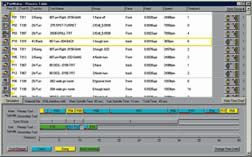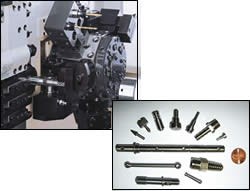Screw Machine Shop Modernizes As It Moves To Medical
CAD/CAM software has been key for this shop to meet the tight lead times necessary to move into the medical market.
Share







Autodesk, Inc.
Featured Content
View More
Takumi USA
Featured Content
View More

Memphis, Tennessee. Minneapolis, Minnesota. Warsaw, Indiana. Ansonia, Connecticut. The first three cities on this list are identified as major hubs for medical device manufacturing. However, HMP Industries, a generations-old screw machine shop, happens to be located in a sleepy town in Southern Connecticut. It also happens to be looking to put itself on the map in the field of medical device manufacturing. The company says it is making its mark by upgrading its massive bank of more than 100 conventional machines to CNC equipment, including a variety of multi-axis CNC Swiss-type lathes.
This new focus on higher-end medical device products and the acquisition of the type of sophisticated equipment needed to make these components forced HMP to reevaluate its programming approach. To survive in the medical device manufacturing arena, the company’s management realized that quoting, programming and setting up parts much faster would be imperative to its success.
The company turned to PartMaker CAD/CAM from PartMaker Inc., a division of Delcam. Implemented in the summer of 2006, the system purchased by HMP programs the company’s range of CNC equipment, including its Tsugami BU20SY, Star SR-20R, Star SB-16 and Kia LMS machines as well as its Fadal machining center, among others.
“Using PartMaker has definitely opened opportunities to us in our medical device business because the software allows us to quote and program faster,” says Steve Whitman, president at HMP. “This means we can deliver faster and meet the short lead times dictated by our medical customers.”
Since opening its doors more than 85 years ago, HMP Industries traditionally focused on making parts for the hand-tool industry on its cam-driven screw machines.
“As the ‘big box’ stores became more dominant and outsourced manufacturing to lower cost markets overseas, we needed to look to other growing markets,” Mr. Whitman says. “We identified the medical market as a prime target because of its growth and its need for the precision machining skills we developed over the years for other industries.”
Making this transition required HMP to look closely at a number of its manufacturing processes, from job quoting through part programming to machine setup of new jobs as the move to medical introduced new materials and parts with more intricate and complex geometries. These parts also require tighter tolerances as well as shorter lead times for both quotes and finished product deliveries.
Prior to implementing the software, HMP’s technical staff had been programming the CNC Swiss as well as the other CNC machines with a combination of manual programming techniques and “cutting and pasting” output from other CAM systems. The approach was particularly inefficient for the Swiss machines.
According to the company, PartMaker has improved productivity by speeding programming time, reducing machine setup time and reducing scrap. Gary Svenson, the chief CNC programmer at HMP, estimates that the new package has reduced the amount of time it takes him to program a part by about 70 percent from the previous method. Additionally, because PartMaker allows him to visually prove out a part on screen with its array of process verification tools, he has also been able to reduce the amount of time required to set up new jobs. Mr. Svenson estimates that the software has in fact reduced machine setup time by about one third.
“When you program parts by hand, you spend a lot of time dry running a part on the machine during setup,” Mr. Svenson says. “With PartMaker, this time is greatly reduced because you know what to expect—you see the part being simulated on screen.”
The 3D simulation capability allows the programmer to verify the machining of a part off-line before sending a program to the machine tool. The fact that the software is equipped with postprocessors for the company's array of machine tools (including all of its Swiss models) offers HMP engineers the assurance that the program will run correctly when it is sent to the machine tool. More accurate part programs are sent to the machine, thus reducing scrap because fewer parts need to be cut before going into final production.
“The software has been helpful in programming some of our more complicated medical parts with more complex geometries,” Mr. Svenson explains. “This was especially important when you take into account the cost of the material for these parts, which are titanium or 17-4-PH stainless steel.”
The capabilities of the new software have allowed the company to maximize the capabilities of its CNC Swiss machines. HMP says it can use the fullest extent of its machines’ numerous axes in an intuitive manner through the Visual Programming strategy. This approach makes programming the milling and turning capabilities of machines such as HMP’s Star SR-20R or Tsugami BU-20SY much easier. The software breaks a complex part into individual face windows. Each window contains features being machined in a particular plane. For example in one window, all turning operations on the machine’s main spindle are programmed graphically. In another window, milling using the machine’s C axis with a horizontally oriented tool may be programmed, while in another a group of features using the machine’s Y axis with a vertically oriented tool may be programmed.
This “divide and conquer” approach greatly simplifies the programmer’s task because it allows him to program a part feature by feature. However, in the world of complex multi-axis turning, just going feature by feature is rarely good enough, says PartMaker. You cannot just always turn and mill, for example.
Once features have been created and correctly ordered, the software is designed to allow the user to synchronize the machines’ numerous programming axes to achieve the best possible cycle time. The software enables this by deploying a Visual Synchronization technology so that the user can choose a picture displaying the synchronous strategy that he or she needs, such as cutting with one tool on the main spindle while another tool is cutting on the sub-spindle, or cutting on the main spindle while the part is being supported on one end by the subspindle.
When the synchronization strategy has been set, the software displays a visual time study, showing the amount of machining time being spent on the main spindle, the amount of cycle time on the subspindle, and the overall cycle time incorporating overlapping machining time. The results are shown in the form of a histogram that clearly indicates where additional opportunities for time savings exist. If the programmer has tried to synchronize operations in a manner in which the machine cannot handle, then the software will point out the error before allowing him or her to proceed.
“Users can discern the areas where they can overlap and save cycle time and reduce the price of a part,” Mr. Zyjeski notes.
Once synchronization is complete, the programmer can simulate the entire machining process in a graphical 3D machining simulation to reduce errors. Once satisfied with the machined model of the part, with one mouse click, the user generates an NC program by choosing the postprocessor for the machine.
Coming from what was essentially a manual programming environment, HMP says it appreciates the accuracy of the program’s postprocessors. In fact, the company has the flexibility to quickly swap a part program from one machine tool to another by postprocessing the part to another machine. As a result of having this flexibility, the company can meet the short lead times demanded by its clients in the medical business.
Using PartMaker to generate more accurate estimates also helps HMP stay competitive. “The software gives us a quick system to get a cycle time estimate on a complicated part with difficult material,” Mr. Zyjeski notes. “We have a high confidence level we will make our estimate.”
Related Content
Orthopedic Event Discusses Manufacturing Strategies
At the seminar, representatives from multiple companies discussed strategies for making orthopedic devices accurately and efficiently.
Read MoreERP Provides Smooth Pathway to Data Security
With the CMMC data security standards looming, machine shops serving the defense industry can turn to ERP to keep business moving.
Read MoreTips for Designing CNC Programs That Help Operators
The way a G-code program is formatted directly affects the productivity of the CNC people who use them. Design CNC programs that make CNC setup people and operators’ jobs easier.
Read MoreHow this Job Shop Grew Capacity Without Expanding Footprint
This shop relies on digital solutions to grow their manufacturing business. With this approach, W.A. Pfeiffer has achieved seamless end-to-end connectivity, shorter lead times and increased throughput.
Read MoreRead Next
Building Out a Foundation for Student Machinists
Autodesk and Haas have teamed up to produce an introductory course for students that covers the basics of CAD, CAM and CNC while providing them with a portfolio part.
Read More5 Rules of Thumb for Buying CNC Machine Tools
Use these tips to carefully plan your machine tool purchases and to avoid regretting your decision later.
Read MoreRegistration Now Open for the Precision Machining Technology Show (PMTS) 2025
The precision machining industry’s premier event returns to Cleveland, OH, April 1-3.
Read More








































.jpg;maxWidth=300;quality=90)










